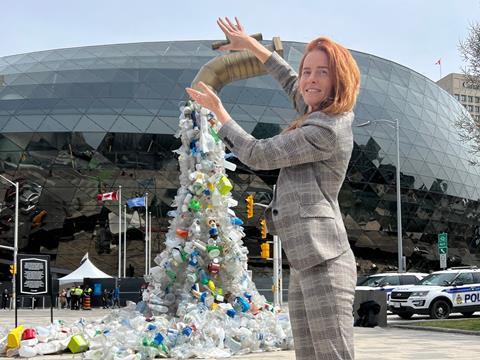
On the final day of the 4th round of negotiations for the United Nations’ Global Plastics Treaty in Ottawa, Willemijn Peeters, founder of Searious Business, gives us an update on her highlights from INC-4 thus far.
On primary plastic polymers there is ever-increasing support for adherence to the UNEA mandate of covering the full life cycle of plastics in the treaty, with emphasis on sustainable production and consumption.
The proposal introduced by Rwanda and Peru, to cap production and set 40% reduction targets on virgin production by 2040, received support from several delegations. Scientists, businesses, civil society and a broad set up governments shared insights on how reduction measures remain to be the single biggest lever to reduce plastic pollution.
As a result, the government of Micronesia launched the ‘Bridge to Busan’ declaration, on primary polymer production. Although some oil-rich countries will find it hard to support this declaration, other governments and stakeholders present were generally supportive.
The Business Coalition for a Global Plastics Treaty is encouraged by the number of proposals (and support for them) that have been tabled around topics such as global rules for restrictions and phase-outs as well as chemicals of concern, which are strongly aligned to the Business Coalition’s position.
On Problematic and avoidable plastic products, many countries have suggested lists, the latest of which is the EU. Many states emphasised and aligned on the need for intersessional work.
On Product Design, Composition and Performance, there is broad support for the provisions suggested. This provision seems to be central to all other main topics, and is specifically mentioned in the agreed text at UNEA-6. As a part, the Extended Producer Responsibility schemes are being discussed in terms of scope and extent at the global level.
A common concern is not to limit EPR to a producer fee, but also include requirements on operational involvement. Reduction and reuse are mentioned as core elements within EPR, thus making EPR a perfect fit for product design instead of waste management.
On alternative plastics, many states supported the view that they must be subject to the same risk reduction as any other plastics, across their life cycle.
On dedicated programmes of work, while there were divergent views on the provisions, Norway suggested a new text proposal, to address different sectors and product groups. Prioritization will be given to sectors with the biggest share of waste generation, short lifespan in use and/or products used in close contact with the environment: packaging, fisheries & aquaculture, agriculture, and textiles.
Examples of additional sectors include but are not limited to transportation, healthcare and medical, construction, and electronics. A dedicated programme of work would create the space to identify safe and sustainable alternatives, identify implementation needs and support the transition to appropriate alternatives.
In order to fund all of these transitions, the Treaty is to provide economic incentives and financial mechanisms. The ‘plastic premium’ has been coined many times in that sense, as have blended finance mechanisms that combine public and private sector efforts.
During the side events, scientists have been highlighting reports on the effects of plastic pollution on human health and the environment, and the costs of inaction.
Throughout the INC process, transparency is widely supported. Yet there are concerns about compliance challenges. Especially the developing countries are stressing the right to have access to information (i.e. on production volumes and origin of raw materials used), on top of the need for capacity building, tech assistance, and tech transfer.
The Chair and several states have stressed it is critical that states speed up progress and build on the solid discussions undertaken to date. States are urged to undertake negotiations firmly focused on achieving outcomes by the end of the session and agree on intersessional workplan for a number of top priorities:
- Criteria to assess and list plastic products and chemicals for bans and phased reductions.
- General and sector-specific requirements for product design and performance towards non-toxic circularity.
- Specific details on implementation measures, including compliance, reporting, and assessment; and on financial mechanisms.
- Ensure progress on treaty draft text ahead of the final adoption at INC-5 in Busan, Republic of Korea.
In a country where leakages in primary plastic production occur by the day, and communities are heavily affected and not informed, it is obvious the pressure is on, not only on Canada but also on others, to live up to ambitions, and safeguard human health and the environment.
If you liked this story, you might also enjoy:
The Brief: How viable is biorecycling for plastics?
Report: How the top brands are progressing on packaging sustainability
The Brief: Using ocean-bound plastic in packaging – how, why and should we?
















No comments yet